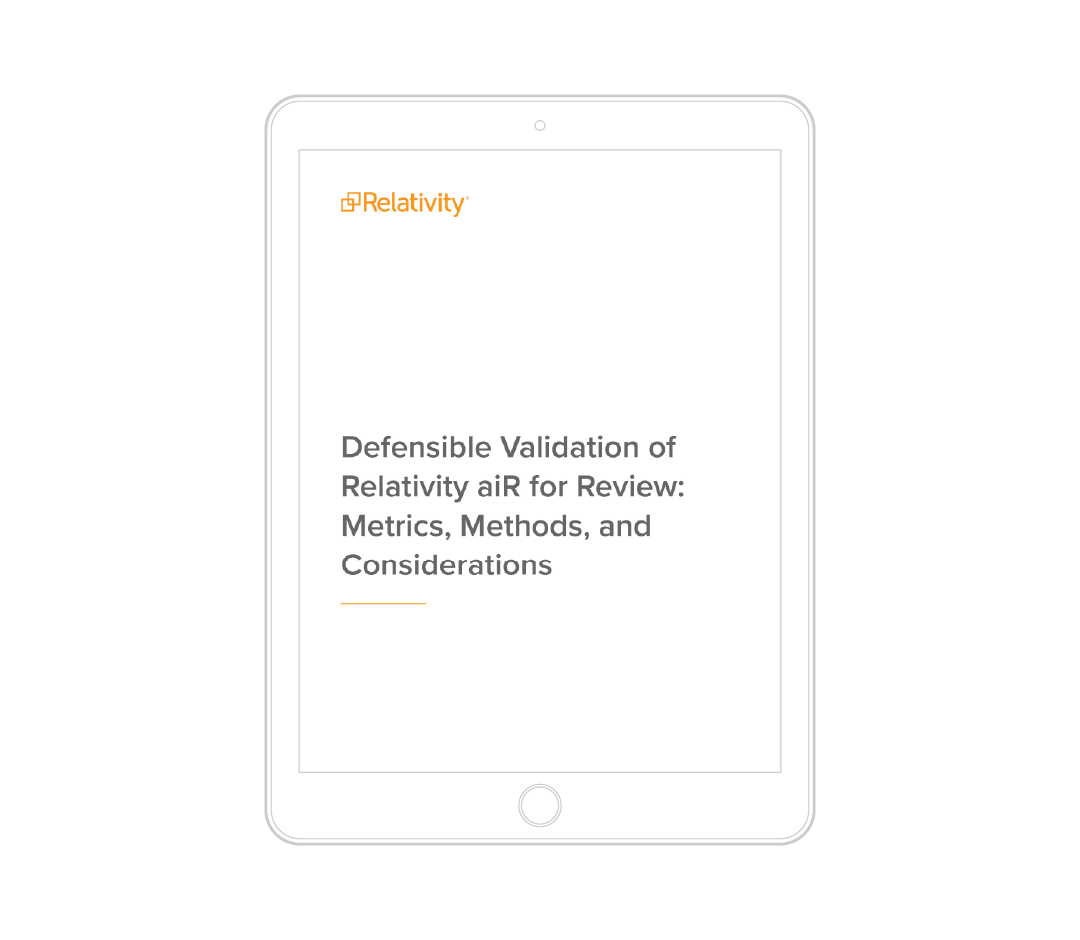Artificial intelligence is rapidly becoming indispensable in legal document review, promising speed, accuracy, and defensibility. Yet, for tech-savvy legal professionals, the greatest value lies in AI’s transparency and explainability.
Relativity aiR for Review leads the way by offering rationales, considerations, citations, and scores for each prediction. These fields transform AI from a “black box” into a collaborative, auditable partner.
How Team Members Gain Value from aiR Explanations
aiR’s explanations deliver tailored value across the review team, empowering attorneys, reviewers, and litigators to work more efficiently and strategically based on their role. Here’s a quick look at how each member can benefit from this in-depth reasoning.
Project Attorneys
These attorneys manage contract attorney review teams, and oversee workflow efficiency, quality control, and defensibility. aiR for Review’s rationale field provides immediate insight into why aiR made specific coding decisions, helping these managers verify alignment with project goals and protocols. For example, high-score documents can be prioritized for review or production, while lower or borderline scores may require sampling or escalation.
Citations, meanwhile, allow instant verification that the conclusions are rooted in actual document content, supporting robust audit trails and compliance
Project attorneys are also highly engaged in the prompt criteria iteration process. Monitoring score distributions and trends in rationales and considerations enables proactive adjustments to prompt criteria during that process, ensuring both efficiency and accuracy. Further, if this reasoning is strategically leveraged, the knowledge and insights gained about critical issues and key documents can make these attorneys some of the most valuable members of the litigation team. Partners, experts, and clients will rely on these attorneys when drafting motions or preparing for depositions, hearings, and trials.
Reviewers
Frontline reviewers can use rationales to streamline their work and grasp the reasoning behind each of aiR’s coding suggestions when conducting supplemental review or QCing the AI’s decisions. For key documents, this often results in improved analysis and more accurate, detailed reviewer comments. This not only benefits the downstream work of the litigation team, but also highlights the exceptional efforts of top review attorneys.
Considerations alert reviewers to potential ambiguities or close calls, prompting closer examination where needed, while citations guide reviewers to the most relevant passages, enabling quicker validation and more consistent decisions.
Litigators and Case Teams
Litigators can use rationales and citations to identify key themes and documents early, enabling quick strategic adjustments and informed legal planning. In an aiR for Review issues project, considerations can be used to highlight risks or strategic uncertainties. Citations offer ready-to-quote evidence for motions, depositions, and negotiations.
This detail can reshape case strategy from the outset. Let’s take a look at how.
Shape Case Strategy Early
When legal teams undertake complex litigation, regulatory, or investigative matters, they face a tough challenge: how to quickly understand vast, disorganized data sets without overlooking key themes or incurring high review costs. aiR for Review fields change this paradigm by enabling legal teams to identify strategic insights much earlier and with far greater precision than before.
Earlier Insights for Better Strategy
At the outset of a complex matter, instead of undertaking the time-consuming and often inexact task of manually creating searches for various key case themes or issues, the team can leverage aiR for Review to:
-
- Identify documents referencing critical issues or specific terminology
- Pinpoint the exact language used in that data
- Flag ambiguous references in documents for further review
- Obtain a score for most documents in the review set
Within days, the team can identify themes, issues, and key players that would have otherwise taken months to uncover, allowing them to consult with the client and make any adjustments to the case theory much earlier in the process.
Faster, Data-Backed Narratives
Instead of reading entire documents for context, reviewers can use rationales and citations to zero in on the specific language that influenced aiR’s prediction. Then, as the team reviews those explanations, new relevant terms, custodians, or issues often emerge. This real-time insight allows teams to refine search terms and dynamically modify the review to focus on what truly matters, rather than relying on static or overinclusive search criteria.
By leveraging aiR’s outputs from the outset, legal teams can quickly present a robust, data-driven narrative to lead counsel or clients. This enables earlier identification of hot documents, the rapid development of case themes, and more targeted documents for deposition.
Drive More Effective Downstream Work
aiR’s in-depth reasoning does more than guide first-level review; it enables a chain of downstream tasks that are faster, more accurate, and more defensible.
- Prompt Criteria Refinement: The detailed rationales and supporting citations reveal exactly why aiR coded a document a certain way. During prompt criteria iteration process, these insights let project attorneys quickly pinpoint the cause of any misinterpretations and adjust the prompt criteria, ensuring that future predictions are increasingly accurate and relevant.
- Quality Control: Instead of targeted random sampling, QC teams can focus on documents where aiR’s scoring rank indicates the document is borderline, or the consideration field flags uncertainty or potential issues. A project attorney can consider using prompt criteria that instructs aiR to flag specific types of documents, or documents on particular topics, to increase the likelihood of catching problematic documents before production. Then, those conducting the QC can use aiR’s explanations to make their final calls more quickly.
- Mass Coding and Tagging: When rationales and citations are clear and consistently aligned with project criteria, teams can confidently mass-tag large populations of documents, drastically reducing manual review time while maintaining defensibility.
- Enhanced Search Strategies: The project attorney can leverage insights and knowledge from rationales and score distributions to create document bundles or develop targeted searches. These improved search options enable the project attorney to respond more efficiently to document requests from the case team or experts.
- Document Bundles for Downstream Teams: Rationales and citations can be packaged together for downstream use, such as deposition preparation or motions and trial support. These ready-made “evidence or deposition bundles” accelerate the work of litigators on the case teams and can be easily shared with experts or clients. The rationale offers a quick summary of why a document is included in the bundle or relevant to the case, and the citations provide access to the appropriate passages without needing to read the entire document.
Build Trust in aiR-Powered Analysis, Blend with Human Expertise
aiR’s field outputs clarify the decision-making process, creating a natural language narrative that is easy to read and understand. This transparency is essential for adoption, trust, and ultimately attorney sign-off and defensibility. The rationale, considerations, citations, and document scores provide an audit trail of sorts, helping to identify errors, locate their source, and take corrective action.
Relativity has specifically designed its aiR tools to encourage human review when aiR is uncertain, promoting a collaborative approach and ensuring that technology acts as an assistive partner, not a replacement. For example, you can always create a human audit plan to review all documents identified as borderline or adopt a scientific/statistical approach through a workflow where review attorneys examine random samples and perform elusion testing.
Being able to both understand the reasoning behind correct decisions, as well as find and correct misinterpretations far more quickly than in manual processes, strengthens confidence in aiR.
Take the Next Steps and Unlock Greater Potential
As an attorney managing various projects and large attorney review teams, I can say that by learning to use and navigate these fields, you will become an indispensable part of your case teams from the outset until the final verdict.
I always recommend the following avenues for those interested in further developing their understanding of Relativity aiR:
- Attend a Relativity Webinar: Deepen your understanding of transparent AI review by attending the next Relativity webinar focused on one of its aiR tools.
- Review the “Generative AI in Legal: How Relativity aiR Reshapes Review” White Paper: For detailed technical and workflow guidance, read this aiR for Review white paper.
- Educate and Encourage Clients: Proactively inform and encourage your clients about the benefits of aiR, highlighting how transparency and explainability enhance both outcomes and defensibility.
Rationales, considerations, citations, and scores are more than technical features; they are the foundation of an actionable, auditable, and trustworthy AI-powered review process. By empowering every team member, accelerating downstream work, and building confidence in aiR outputs, these fields bridge the gap between advanced technology and the high standards of legal practice.
As generative AI becomes central to legal workflows, explainable solutions like Relativity aiR are essential for harnessing the full power of technology while maintaining expertise, judgment, and ethical rigor.
Graphics for this article were created by Caroline Patterson.












